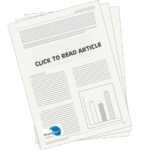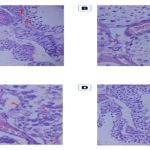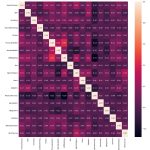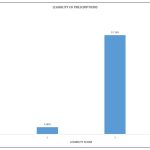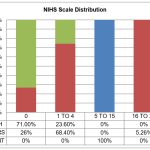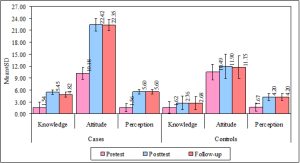
Background: Abuse of topical corticosteroids is a growing concern for dermatologists in India. It manifests itself in a variety of ways, most frequently on the face. Important underlying issues include a lack of public knowledge and the simplicity of acquiring topical corticosteroids without a prescription. There is a need to take urgent remedial steps and increase awareness about this problem in Health Science Student Population. Therefore, our study aims to assess and evaluate the Knowledge, Attitude and Perception (KAP) among health science student population regarding usage of topical corticosteroids. Materials and Methods: A Randomized case control study carried out among health science student population. A Self-prepared and validated KAP questionnaires were distributed to the health science student population through online forms and face-to-face interview were done after seminar was conducted in case group using audio-video visuals and only subject information leaflet is given in control group then post study was done after 1 month and follow-up after 3 months with the same set of questionnaires. Results: Out of 520 students women made up 69.23% more participants than men. The percentage of people aged 20 to 30 was 71.15%. Most of the participants were undergraduates with 81.15%. Pharmacy (22.69%) is the field with the highest enrolment, followed by Ayurveda, Nursing, Physiotherapy, Medical, dental and allied degrees. Case group showed significant improvement in KAP score respectively compared to control group (p<0.05). Conclusion: Educating with audio video visuals and seminar shows significant improvement in KAP scores compared to giving subject information leaflet.

Background: Congenital Diaphragmatic Hernia (CDH) is a diaphragm abnormality it permits stomach contents to protrude into the thoracic cavity, posing a substantial risk for pulmonary and cardiac problems in newborns. The pathophysiology of congenital diaphragmatic hernia is a combination of lung hypoplasia and immaturity associated with Persistent Pulmonary Hypertension (PPHN) in newborns and cardiac dysfunction. Case Presentation: A 1-year-old male patient was admitted to the hospital with chief complaints of excessive crying, breathlessness, and fever for one month. On examination, we observed decreased air entry on the right side in the inframammary area, and no air entry in the infra-axillary area. The Ultrasonography (USG) of the chest showed bowel loops along with mesentery. Surgical correction is required for a diaphragmatic hernia. Right thoracotomy, laparotomy, and repair of hernia were done Conclusion: The Prior diagnosis during the pre-natal period induces a better prognosis.
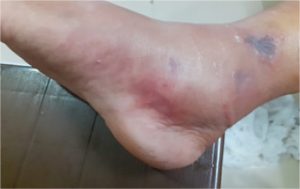
Presenting case report of necrotizing fasciitis, a rare bacterial infection, bacteria grow in the superficial layer of the fascia and release toxins, causing the infection to spread through the fascia. This is a serious disease that spreads quickly and requires immediate treatment. Compartment syndrome is one of the complications of necrotizing fasciitis. The prognosis is reliable based on clinical examination and assessment of intracompartmental pressure. Severe pain is important sign of this. Either the relatively rigid and closed muscle space, which is enclosed by fascia and bone, experiences bleeding and oedema. The case is unique in terms of the misdiagnosis and complication of the disease. Patient ageing forty-four years came to an emergency room with the complaint of pain, redness and severe swelling in right leg in the last 7 days. He went to a local hospital a week ago where cellulitis was diagnosed but before 2 days the swelling and pain got severe and so he came in as an emergency. It was noted here that he was misdiagnosed by cellulitis and so Laboratory Risk Indicator for Necrotizing Fasciitis (LRINEC) score was performed which revealed the intermediate risk of necrotizing Fasciitis. He was immediately admitted to operation room for surgical procedure called debridement with fasciotomy, after the surgery antibiotic treatment started and was continued for a week. Along with this, dressing of the surgical site was performed. Plastic surgery was done at surgical site after 15 days. With this treatment the recovery was good and the therapeutic goals were all achieved. So, it is better that this type of diagnosis should be identify at stage-1 to decrease the mortality rate.
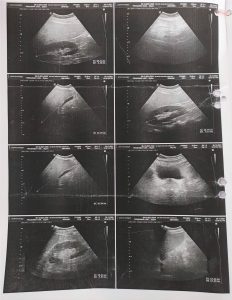
Anabolic androgenic steroids are a type of synthetic testosterone which are most likely used by athletes, body builders and physicians to increase male sex hormones in those who have not yet reached puberty. We present the case of 32-years-old male patient who was admitted in respiratory ward with complaints of breathlessness and weakness. Patient had history of left hydropneumothorax secondary due to pulmonary tuberculosis, iatrogenic cushing syndrome and was misusing anabolic androgenic steroids for muscle gain for a long time. The laboratory investigations were noted that elevation of liver function tests, abnormal haematological tests, ultrasonography was revealed to be hepatomegaly with grade II fatty liver. The patient was treated with the Dexamethasone, combination of Piperacillin and Tazobactam, combination of Metadoxine, Silymarin and l-Ornithinel-Aspartate (LOLA), Clonazepam, Ketoconazole and his health condition improved enough for him to be discharged. In conclusion we recommend the health care professionals to review the safety profile, examine laboratory results and counsel patients to prevent further abusage of anabolic androgenic steroids.
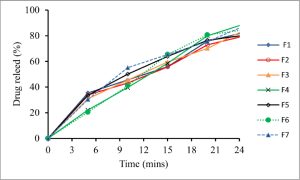
Background:
Albendazole is a bitter drug and a common antihelmintic drug with a wide range of effects due to its first-pass metabolism and limited bioavailability. It is available in oral dosage form to treat various intestinal illnesses. The goal of this study is to develop a new oral dosage form, a gelatin-based chewable, for pediatrics and devise a dosage form that is easier to take, tastes better, and does not smell strange.
Materials and Methods:
Gelatin (natural polymer used as gelling agent), sucrose and sorbitol, albendazole (active ingredient), citric acid and sodium benzoate, flavorant, and colorant were used. The study involves the formation of two separate solutions according to standard protocols. The first solution contained sorbitol, sucrose, and water 1:1, with a water-to-sorbitol ratio of 2:1. In order to make the second solution, water and gelatin were mixed and heated at 60°C. Both solutions were mixed, followed by the addition of other excipients.
Results:
Preformulation studies involved bulk characterization and solubility analysis. Solubility analysis (pKa determination and partition coefficient) was carried out. Post-formulation studies were carried out to characterize the formulation, including in vitro disintegration and dissolution. A release kinetics study of the formulation revealed that these gummies followed first-order kinetics because it is an immediate-release formulation.
Conclusion:
The developed formulation of albendazole gummies was found to be similar to other formulations of albendazole available in the market in terms of physiochemical parameters and therefore can be produced as a generic formulation by an interested local pharmaceutical industry in the country.

